
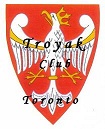
+ MERRY CHRISTMAS +
+ WESOŁYCH ŚWIĄT BOŻEGO NARODZENIA +

+ JOYEUSES NOËL +
+ FELIZ NAVIDAD +
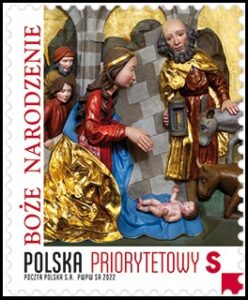

TROYAK EXECUTIVE TEAM is informing all members, colleagues, collectors, and Polonia at large, that Club meetings taking place at John Paul II Polish Cultural Centre, 4300 Cawthra Rd. (just south of Hwy. 403), Mississauga, Ontario. The new members are always welcome. www.polishculturalcentre.ca
ADRES SPOTKAÑ KLUBOWYCH ! Zarząd Główny Klubu “Troyak” informuje wszystkich członków kolekcjonerów, sympatyków oraz całą Polonię, że spotkania klubowe odbywają się w Polskim Centrum Kultury im. Jana Pawła II, przy 4300 Cawthra Rd. (na południe od autostrady 403), Mississauga, Ontario. Zapraszamy nowych członków do prężnego. Klubu “Troyak”. www.polishculturalcentre.ca

“TROYAK” CLUB NEXT MEETINGS …
NASTĘPNE SPOTKANIA KLUBU “TROYAK” …
December 2022 … Happy Holidays!
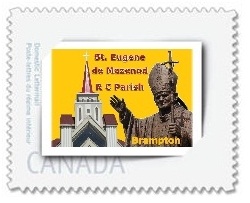
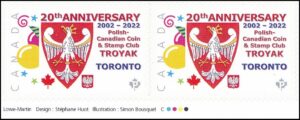
15th January 2023 @ 4:30 p.m. …
… Annual General Meeting
29th January 2023 @ 4:30 p.m.
26th February 2023
Sunday – 5th March 2023 @ 9:00 a.m. to 4:00 p.m.
Mississauga Coin & Stamp Show
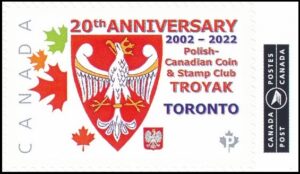
26th March 2023 @ 4:30 p.m.
30th April 2023
28th May 2023; 25th June 2023
July & August 2023 – Summer break … Letnie wakacje …
30th September 2023; 29th October 2023
26th November 2023
December 2023 … Happy Holidays!


Józef Wybicki – autor słów hymnu Polski
www.poczta-polska.pl
Dnia 29 września 2022 r. z okazji 225. rocznicy napisania przez Józefa Wybickiego „Mazurka Dąbrowskiego” i 95. rocznicy ustanowienia tej pieśni hymnem Polski, Poczta Polska wprowadziła do obiegu znaczek pocztowy o wartości 3,60 zł emisji “Józef Wybicki – autor słów hymnu Polski” i najważniejszej narodowej pieśni. Z tej okazji została wydana również koperta FDC. Na znaczku przedstawiono portret Józefa Wybickiego, wg drzeworytu z 1871 r. W grafice przywieszki – rycina “Marsz, marsz Dąbrowski…” z cyklu “Pieśń Legionów” Juliusza Kossaka. W grafice oprawy arkusza – fragmenty ryciny “Niemiec, Moskal nie osiędzie…” – z cyklu “Pieśń Legionów” Juliusza Kossaka, fragmenty autografu “Pieśni Legionów Polskich we Włoszech”.

W prawym górnym rogu kod QR przekierowujący do strony z nagraniem hymnu Polski w wykonaniu Reprezentacyjnego Zespołu Artystycznego Wojska Polskiego. W grafice koperty FDC trzy grafiki Juliusza Kossaka z cyklu “Pieśń Legionów” – “Marsz, marsz Dąbrowski”, “Dał nam przykład Bonaparte…” i “Jak Czarniecki do Poznania” oraz autograf “Pieśni Legionów Polskich we Włoszech”. W grafice datownika – podpis Józefa Wybickiego. Wnioskodawcą emisji jest Ministerstwo Spraw Zagranicznych. Emisja powstała w ścisłej współpracy z Muzeum Hymnu Narodowego w Będominie oddziału Muzeum Narodowego w Gdańsku. Wszystkie materiały użyte w emisji pochodzą ze zbiorów Muzeum. Znaczek wydrukowano techniką offsetową, na papierze fluorescencyjnym, w formacie: 40,5 x 40,5 mm, w nakładzie 135 000 sztuk. Arkusz zawiera 5 szt. znaczków i przywieszkę. Autor projektu: Jan Konarzewski.
– Poczta Polska to wyjątkowa instytucja. Losy naszej firmy nierozerwanie związane są z istnieniem rodzimej państwowości. Po odrodzeniu się niepodległego państwa polskiego, po 123 latach zaborów, rolą Pocztowców było połączenie trzech zaborów w jeden wspólny organizm. Poczta stała się symbolem jedności ziem w granicach RP. Podobną funkcję pełnił hymn narodowy. „Mazurek Dąbrowskiego” zjednoczył Polaków. Śpiewając te najważniejszą pieśń odczuwamy dumę i poczucie przynależności do narodu polskiego. Józef Wybicki, komponując słowa do utworu, który stał się hymnem, wniósł nieoceniony wkład w budowanie tożsamości i jedności narodowej, za co oddajemy mu, poprzez tę wyjątkową emisję, hołd. Sejm Rzeczypospolitej Polskiej, ustanowił rok 2022 Rokiem Józefa Wybickiego – podkreślił prezes Poczty Polskiej, Krzysztof Falkowski.
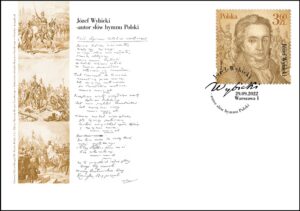
Znaczek „Józef Wybicki – autor słów hymnu Polski” wpisuje się w założenia polityki emisyjnej Spółki. Poczta Polska upamiętnia na znaczkach wydarzenia związane z przynależnością narodową i dziedzictwem historycznym Polski. Emisja znaczka poświęconego autorowi polskiego hymnu przypada w rocznicę urodzin Józefa Wybickiego.
– Szacunek oddawany symbolom narodowym wynika nie tylko z ustawowego obowiązku, ale przede wszystkim z potrzeby serca. Dziś w 275. rocznicę urodzin i 200. rocznicę śmierci Józefa Wybickiego oraz w 225. rocznicę powstania Pieśni Legionów Polskich we Włoszech i 95. rocznicę ustanowienia „Mazurka Dąbrowskiego” hymnem narodowym Poczta Polska przypomina niezwykłą postać żołnierza i patrioty, autora słów polskiego hymnu. Przez lata przyzwyczailiśmy naszych klientów do tego, że wydawane przez nas znaczki mają nie tylko charakter upamiętniający, ale przede wszystkim edukujący. Dla młodego pokolenia Polaków nasz znaczek niech będzie przypomnieniem, że symbole narodowe niosą wartości, o które kiedyś walczono do ostatniej kropli krwi – powiedział wiceprezes Poczty Polskiej Wiesław Włodek.

100-lecie Polskiego Przemysłu Chemicznego
www.poczta-polska.pl
W dniu 29 września 2022 r. została wprowadzona do obiegu kartka pocztowa z nadrukowanym znakiem opłaty pocztowej, emisji: 100-lecie Polskiego Przemysłu Chemicznego. Wartość nominalna znaku opłaty pocztowej z oznaczeniem literowym A odpowiada wartości nominalnej znaczka pocztowego używanego do uiszczenia opłaty za ekonomiczną przesyłkę listową nierejestrowaną, w tym kartkę pocztową, w obrocie krajowym, w formacie S. Założeniem projektu jest uhonorowanie 100-lecia Polskiego Przemysłu Chemicznego, zapoczątkowanego przejęciem fabryki związków azotowych w Królewskiej Hucie w Chorzowie z rąk niemieckich po powstaniach śląskich.
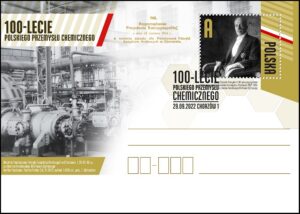
Na znaczku pocztowym widnieje wizerunek Ignacego Mościckiego Prezydenta Rzeczpospolitej Polskiej, pierwszego dyrektora fabryki i współzałożyciela Państwowej Fabryki Związków Azotowych w Mościcach, obecnej dzielnicy Tarnowa. Z kolei w części ilustracyjnej znajduje się zdjęcie widoku wnętrz fabryki i fragment Rozporządzenia Prezydenta RP z dn. 28.06.1924 r. o nadaniu statutu dla Państwowej Fabryki Związków Azotowych w Chorzowie. Wnioskodawcą kartki jest Grupa Azoty S.A. Kartkę o wymiarach 148 x 105 mm wydrukowano jednostronnie, techniką offsetową, na kartonie białym, w nakładzie 5000 sztuk. Autor projektu kartki: Jarosław Ochendzan.

Polskie dworce kolejowe
www.poczta-polska.pl
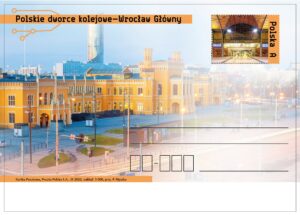
W dniu 30 września 2022 r. zostały wprowadzone do obiegu trzy kartki pocztowe z nadrukowanym znakiem opłaty pocztowej, emisji: Polskie dworce kolejowe. Wartość nominalna znaku opłaty pocztowej z oznaczeniem literowym A odpowiada wartości nominalnej znaczka pocztowego używanego do uiszczenia opłaty za ekonomiczną przesyłkę listową nierejestrowaną, w tym kartkę pocztową, w obrocie krajowym, w formacie S. Na kartkach, w prawym górnym rogu strony adresowej kartki nadrukowano znak opłaty pocztowej, na których wzdłuż prawej krawędzi umieszczono napis: Polska oraz oznaczenie wartości: A, a ponadto przedstawiono: na pierwszej – fotografię wnętrza dworca kolejowego we Wrocławiu; na drugiej – fotografię wnętrza dworca kolejowego Poznań Garbary; na trzeciej -fotografię wnętrza dworca kolejowego w Oświęcimiu.

W części ilustracyjnej kartek przedstawiono: 1) na pierwszej – fotografię budynku dworca kolejowego we Wrocławiu, a w górnej części napis: Polskie dworce kolejowe – Wrocław Główny; 2) na drugiej – fotografię budynku dworca kolejowego Poznań Garbary, a w górnej części napis: Polskie dworce kolejowe – Poznań Garbary; 3) na trzeciej – fotografię budynku dworca kolejowego w Oświęcimiu, a w górnej części napis: Polskie dworce kolejowe – Oświęcim. Kartki pocztowe powstały we współpracy z Polskimi Kolejami Państwowymi S.A. Kartkę o wymiarach 148 x 105 mm wydrukowano jednostronnie, techniką offsetową, na kartonie białym, w nakładzie 5000 sztuk. Autor projektu kartki: Paweł Myszka.


Muzeum Kolei Wąskotorowej w Sochaczewie
www.poczta-polska.pl
W dniu 30 września 2022 r. została wprowadzona do obiegu kartka pocztowa z nadrukowanym znakiem opłaty pocztowej, emisji: Muzeum Kolei Wąskotorowej w Sochaczewie. Wartość nominalna znaku opłaty pocztowej z oznaczeniem literowym A odpowiada wartości nominalnej znaczka pocztowego używanego do uiszczenia opłaty za ekonomiczną przesyłkę listową nierejestrowaną, w tym kartkę pocztową, w obrocie krajowym, w formacie S.

W prawym górnym rogu strony adresowej kartki nadrukowano znak opłaty pocztowej, na którym umieszczono wizerunek starej lokomotywy oraz nazwę STACJA MUZEUM SOCHACZEW. W części ilustracyjnej kartki – fotografia przedstawiająca przedwojenny parowóz Px29-1704, prowadzący pociąg retro, nad nim – logotyp obchodów 100-lecia istnienia Kolei Wąskotorowej w Sochaczewie. Kartkę o wymiarach 148 x 105 mm wydrukowano jednostronnie, techniką offsetową, na kartonie białym, w nakładzie 5000 sztuk. Autor projektu kartki: Joanna Fleszar-Haspert.

16. Międzynarodowy Konkurs Skrzypcowy
im. Henryka Wieniawskiego
www.poczta-polska.pl
W dniu 7 października 2022 roku został wprowadzony do obiegu znaczek pocztowy o wartości 3,90 zł emisji “16. Międzynarodowy Konkurs Skrzypcowy im. Henryka Wieniawskiego”. Wnioskodawcą tematu emisji jest Towarzystwo Muzyczne im. Henryka Wieniawskiego w Poznaniu. Międzynarodowy Konkurs Skrzypcowy im. Henryka Wieniawskiego to konkurs młodych talentów, wirtuozów gry na skrzypcach. Do tegorocznego konkursu zgłosiło się 224 kandydatów, a 41 zakwalifikowało się do konkursu finałowego. Ilu artystów tyle dźwięków, ile dźwięków tyle wykonań. Na znaczku emisji “16. Międzynarodowego Konkursu Skrzypcowego im. Henryka Wieniawskiego” przedstawione zostało symboliczne połączenie harmonii wielu różnych dźwięków, taktów i fraz. Poprzez wielość i różnorodność elementów ukazany został ekspresyjny charakter festiwalu.
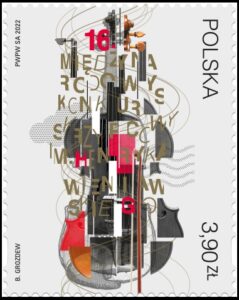
Owa mnogość aranżacji składa się na jeden, czytelny – obraz skrzypiec. Symbol ten towarzyszy także całej identyfikacji tegorocznego festiwalu i został dodatkowo wyeksponowany graficznie w datowniku.
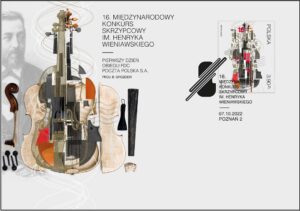
Koperta prezentuje pełniejszą wersję alegorii “skrzypiec wielu dźwięków” wzbogaconą o dodatkowe elementy lutniczego warsztatu, jak pudło czy gryf. Podobnie jak na znaczku, każdy z oddzielnych fragmentów utworu łączy się i buduje jeden instrument. W tle przedstawiona została także pięciolinia, która finezyjnie wygięta, oplata główne części kompozycji i jest bazą dla unoszących się dźwięków. W tle wizerunek Henryka Wieniawskiego Znaczki wydrukowano techniką offsetową, na papierze fluorescencyjnym, w formacie 31,25 x 39,5 mm, w nakładzie 144 000 sztuk. Arkusz sprzedażny zawiera 12 sztuk znaczków. Autor projektu: Bożydar Grozdew.

100-lecie morskiego szkolnictwa wojskowego
www.poczta-polska.pl
W dniu 7 października 2022 roku został wprowadzony do obiegu znaczek pocztowy o wartości 3,90 zł emisji “100-lecie morskiego szkolnictwa wojskowego”. Na znaczku przedstawiono młodych oficerów Marynarki Wojennej na tle budynku Akademii Marynarki Wojennej im. Bohaterów Westerplatte w Gdyni. Znaczki wydrukowano techniką offsetową, na papierze fluorescencyjnym, w formacie 43 x 31,25 mm, w nakładzie 126 000 sztuk. Arkusz sprzedażny zawiera 9 sztuk znaczków. Autor projektu: Poczta Polska. Oprócz waloru filatelistycznego do obiegu trafiła również koperta FDC (Pierwszego Dnia Obiegu). W widocznej na niej grafice wkomponowano fotografię przedstawiającą szable.

Poczta Polska wprowadziła do obiegu znaczek pocztowy poświęcony 100. rocznicy Wyższego Wojskowego Szkolnictwa Morskiego. Uroczysta prezentacja tego wyjątkowego waloru filatelistycznego odbyła się 21 października br. w Gdyni na Akademii Marynarki Wojennej im. Bohaterów Westerplatte.
W uroczystości z okazji 100. rocznicy wziął udział Krzysztof Falkowski, Prezes Poczty Polskiej. Nowy walor filatelistyczny to kolejny wspólny projekt realizowany przez Pocztę Polską z Akademią Marynarki Wojennej w Gdyni. Współpraca Spółki z Uczelnią trwa od kilku lat i jest następstwem m.in. porozumienia, które w 2020 roku zawarły ze sobą oba podmioty. Porozumienie dotyczyło m.in. współpracy w zakresie doskonalenia kadr Poczty Polskiej oraz wspólnego przygotowywania i prowadzenia przedsięwzięć wpisujących się w misję i potrzeby obu instytucji.
– Poczta Polska intensywnie rozwija obszar usług cyfrowych, a także wdraża nowoczesne rozwiązania wspierające cyberbezpieczeństwo, współpracujemy w tej dziedzinie z Akademią. Tym bardziej cieszy mnie, że mogliśmy uhonorować emisją filatelistyczną 100. rocznicę Wyższego Wojskowego Szkolnictwa Morskiego, którego tradycje kultywuje ta znakomita Uczelnia i jest ich chlubną częścią. Akademia Marynarki Wojennej to nie tylko uczelnia wojskowa, to także prężny ośrodek kształcenia w obszarze cyfrowym – tak istotnym w obecnym świecie. Poczta Polska identyfikuje się ze wszelkimi działaniami, które służą upowszechnianiu wiedzy na temat cyberbezpieczeństwa, dlatego też uruchomiła wraz z AMW studia podyplomowe MBA – powiedział Krzysztof Falkowski, prezes Poczty Polskiej.
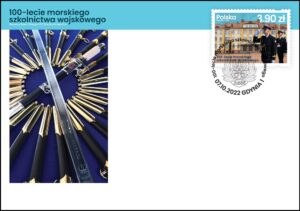
Akademia Marynarki Wojennej to uczelnia wyższa, która kształci podchorążych, oficerów oraz cywili na kierunkach związanych z nawigacją, mechaniką morską oraz obronnością. W murach AMW studenci i kursanci zdobywają wiedzę, umiejętności praktyczne oraz mogą korzystać z różnego rodzaju symulatorów czy laboratoriów. Studenci wojskowi mogą kształcić się na pięciu kierunkach: nawigacji, mechanice i budowie maszyn, mechatronice, informatyce oraz systemach informacyjnych w bezpieczeństwie. Studenci cywilni mają z kolei do wyboru aż trzynaście kierunków, do których należą, m.in. bezpieczeństwo narodowe, bezpieczeństwo wewnętrzne, bezpieczeństwo morskie państwa czy systemy informacyjne w bezpieczeństwie.
– Jesteśmy wdzięczni Poczcie Polskiej za uhonorowanie naszego jubileuszu znaczkiem pocztowym. Nasza współpraca w ostatnich latach stale się rozwija i intensyfikuje. Wspólnie realizujemy z powiedzeniem wiele przedsięwzięć o charakterze edukacyjnym, należą do nich Letnia Szkoła Cyberbezpieczeństwa, studia MBA, a wkrótce także DBA. Teraz dołącza do nich emisja filatelistyczna, która uświetnia nasze jubileuszowe obchody – podkreślił kadm. prof. dr hab. Tomasz Szubrycht, rektor-komendant Akademii Marynarki Wojennej.

Święty Archanioł Gabriel –
patron pocztowców i filatelistów
www.poczta-polska.pl
W dniu 18 października 2022 roku, przy okazji corocznych obchodów Dnia Łącznościowca w Katowicach, został wprowadzony do obiegu znaczek pocztowy o wartości 3,90 zł emisji “Święty Archanioł Gabriel – patron pocztowców i filatelistów”. Na znaczku przedstawiono św. Archanioła Gabriela na podstawie wizerunku zamieszczonego na sztandarze Poczty Polskiej S.A. Autorem wizerunku św. Archanioła Gabriela na sztandarze pocztowym jest franciszkanin o. Tomasz Jank – Gwardian Klasztoru i Rektor Kościoła św. Trójcy w Gdańsku. Znaczki wydrukowano techniką offsetową, na papierze fluorescencyjnym, w formacie 45 x 45 mm, w tym koło o średnicy 40 mm, w nakładzie 128 000 sztuk. Arkusz sprzedażny zawiera 8 sztuk znaczków. Z tej okazji została wydana koperta FDC. Autor projektu: Roch Stefaniak.
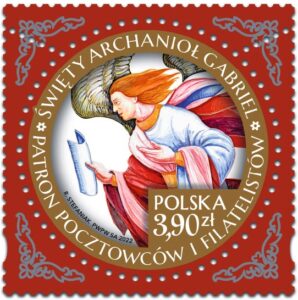
Emisja pocztowa wydawana jest w związku z przypadającą 9 grudnia – 50. rocznicą ogłoszenia przez papieża Pawła VI, Archanioła Gabriela patronem środków społecznego przekazu, poczty i filatelistów. Uczynił to na prośbę filatelistów austriackich w 1972 roku, wydając brewe apostolskie „Quandoquidem mortalium vita”. Takie powiązanie wynika z roli i sposobu przedstawiania Św. Gabriela w tradycji ikonograficznej, jako uskrzydlonej postaci, która z nieba schodzi na ziemię, żeby przekazać ludziom wiadomości od Boga. Wnioskodawcą tematu emisji był Ogólnopolski Klub Zbieraczy Znaków Pocztowych o Tematyce Religijnej „Święty Gabriel”. Wizerunkowi archanioła towarzyszą atrybuty: berło (symbol nadanej mu przez Boga władzy); lilia (pokój) oraz gałązka oliwna lub gałązka palmowa. W ikonografii czasami uwzględnia się również trąbę, harfę lub zwój (symbol wiedzy i mądrości).
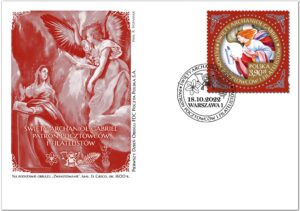
Motywy religijne są częstym tematem znaczków pocztowych, jednak obecna emisja Poczty Polskiej jest wyjątkowa. Przedstawia bowiem jednego z najpopularniejszych aniołów, który kojarzony jest z tak poważnymi sprawami, jak zmartwychwstanie, zwiastowanie, miłosierdzie, kara, śmierć i objawienie. Imię Gabriel oznacza: „Bóg jest moją siłą”, „mąż Boży”, „wojownik Boży”. Jest jednym z najwyższych rangą aniołów, zgodnie z tradycją chrześcijańską zaliczony został do grona trzech archaniołów o szczególnym znaczeniu.

BOŻE NARODZENIE
www.poczta-polska.pl
W dniu 20 października 2022 został wprowadzony do obiegu znaczek pocztowy beznominałowy o wartości odpowiadającej opłacie za priorytetową przesyłkę listową nierejestrowaną w obrocie krajowym w formacie S i priorytetową kartkę pocztową, emisji “Boże Narodzenie”. Na znaczku przedstawiono scenę Narodzenia Pana Jezusa z poźnogotyckiego poliptyku szafiastego z 1504 roku, pochodzącego z bazyliki archikatedralnej we Fromborku. Na kopercie FDC widnieje Madonna z głównej część późnogotyckiego poliptyku z 1504 r., z bazyliki archikatedralnej Wniebowzięcia Najświętszej Maryi Panny i św. Andrzeja we Fromborku
Wnioskodawcą tematu emisji Boże Narodzenie jest Poczta Polska. Merytorycznym konsultantem przy emisji jest ks. Jacek Wojtkowski rektor bazyliki. Znaczek wydrukowano techniką rotograwiurową, na papierze fluorescencyjnym, w formacie: 25,5 mm x 31,25 mm , w nakładzie 2 000 000 sztuk, powtarzalnym. Arkusz zawiera 100 szt. znaczków. Autor projektu znaczka: Poczta Polska S.A.

Prezentacja znaczka pocztowego emisji „Boże Narodzenie” odbyła się 20 października 2022r. podczas I. Kongresu SACRIS „Dobra Kościoła – Troska i Odpowiedzialność” we fromborskiej Bazylice Archikatedralnej Wniebowzięcia Najświętszej Maryi Panny i św. Andrzeja. W uroczystości wzięli udział m.in. Przemysław Czarnek – Minister Edukacji i Nauki, Andrzej Śliwka – podsekretarz stanu w Ministerstwie Aktywów Państwowych, ks. abp Józef Górzyński – metropolita warmiński. Pocztę Polską reprezentował – wiceprezes Wiesław Włodek.
– Poczta Polska doskonale rozumie swoją misję i siłę przekazu jaką dysponujemy. Znaczki pocztowe oraz kartki z nadrukowanym znaczkiem opłaty pocztowej są idealnym instrumentem do krzewienia świadomości duchowej. Na naszych walorach filatelistycznych od lat regularnie przedstawiamy serie emisji takie jak: „Sztuka sakralna”, „Patroni Polski”, „Święci i błogosławieni”, „Zabytkowe organy w Polsce”. Możliwość uczestnictwa w I Kongresie SACRIS „Dobra Kościoła – Troska i Odpowiedzialność” jest dla mnie zaszczytem ponieważ daje możliwość zaprezentowania misyjnego działania Poczty Polskiej – powiedział Wiesław Włodek, wiceprezes Poczty Polskiej.
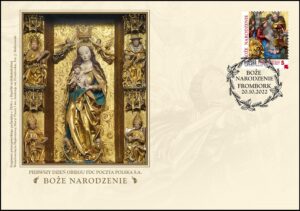
Do stworzenia grafiki znaczka wybrano jedno z czterech skrzydeł bocznych zabytkowego poliptyku szafiastego przedstawiające Narodzenie Pana Jezusa. W szacie graficznej koperty FDC widnieje fotografia głównej części fromborskiej szafy ołtarzowej, na której została przedstawiona ukoronowana figura Najświętszej Maryi Panny w typie dziewicy apokaliptycznej trzymająca na rękach Dziecię Jezus. Merytorycznym konsultantem przy emisji znaczka Poczty Polskiej był ks. dr Jacek Wojtkowski, rektor Bazyliki Archikatedralnej we Fromborku.

100. rocznica powołania Najwyższego Trybunału
Administracyjnego
www.poczta-polska.pl
W dniu 23 października 2022 r. została wprowadzona do obiegu kartka pocztowa z nadrukowanym znakiem opłaty pocztowej, emisji: 100. rocznica powołania Najwyższego Trybunału Administracyjnego. Wartość nominalna znaku opłaty pocztowej z oznaczeniem literowym A odpowiada wartości nominalnej znaczka pocztowego używanego do uiszczenia opłaty za ekonomiczną przesyłkę listową nierejestrowaną, w tym kartkę pocztową, w obrocie krajowym, w formacie S.
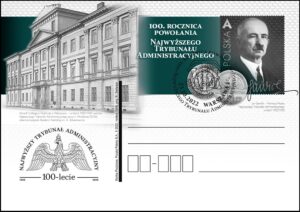
W części ilustracyjnej kartki przedstawiono gmach Collegium Nobilium w Warszawie, pierwszej siedziby NTA, a poniżej logotyp obchodów 100-lecia Najwyższego Trybunału Administracyjnego. W polu przywieszki umieszczono tytuł emisji: ,,100. rocznica powołania Najwyższego Trybunału Administracyjnego” oraz awers i rewers medalu wytłoczonego z tej okazji. W polu znaku opłaty pocztowej umieszczono portret Jana Sawickiego, pierwszego prezesa Najwyższego Trybunału Administracyjnego. W lewym górnym rogu umieszczono oznaczenie wartości: A, wzdłuż lewej krawędzi napis: POLSKA. Kartka została zaprojektowana w ścisłej współpracy z Naczelnym Sądem Administracyjnym – wnioskodawcą emisji. Kartkę o wymiarach 148 x 105 mm wydrukowano jednostronnie, techniką offsetową, na kartonie białym, w nakładzie 5000 sztuk. Autor projektu kartki: Roch Stefaniak.

100. rocznica powstania polskich związków
sportowych-zapasy
www.poczta-polska.pl
W dniu 31 października 2022 r. została wprowadzona do obiegu kartka pocztowa z nadrukowanym znakiem opłaty pocztowej, emisji: 100. rocznica powstania polskich związków sportowych. Wartość nominalna znaku opłaty pocztowej z oznaczeniem literowym A odpowiada wartości nominalnej znaczka pocztowego używanego do uiszczenia opłaty za ekonomiczną przesyłkę listową nierejestrowaną, w tym kartkę pocztową, w obrocie krajowym, w formacie S.
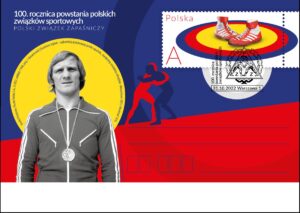
W części ilustracyjnej kartki przedstawiono postać najbardziej utytułowanego polskiego zapaśnika, dwukrotnego medalisty olimpijskiego, Kazimierza Lipienia i zarys postaci zapaśników w tle. W lewej górnej części kartki umieszczono nazwę emisji ,,100. rocznica powstania polskich związków sportowych” i napis: Polski Związek Zapaśniczy. W polu znaku opłaty pocztowej w części centralnej umieszczono grafikę przedstawiającą atrybuty zapasów: matę i buty zapaśnicze. W lewym dolnym rogu umieszczono oznaczenie wartości: A, a w lewym górnym rogu napis: POLSKA. Kartka została zaprojektowana we współpracy z Polskim Związkiem Zapaśniczym. Kartkę o wymiarach 148 x 105 mm wydrukowano jednostronnie, techniką offsetową, na kartonie białym, w nakładzie 5000 sztuk. Autor projektu kartki: Jan Konarzewski.

100-lecie Portu Gdynia
www.nbp.pl
Narodowy Bank Polski jest centralnym bankiem państwa odpowiadającym za politykę pieniężną i stabilność cen. Jego funkcje określa Konstytucja Rzeczypospolitej Polskiej i ustawa o NBP. NBP ma wyłączne prawo emisji pieniądza. Jako bank centralny nie prowadzi rachunków bankowych obywateli, nie przyjmuje od nich lokat, nie udziela kredytów. Prowadzi natomiast obsługę budżetu państwa, a także podmiotów sektora finansów publicznych. Gromadzi rezerwy walutowe państwa i zarządza nimi. Pełni funkcję banku banków, tworząc warunki do działania systemu bankowego. Jest również jednym z najważniejszych ośrodków naukowo-analitycznych w dziedzinie ekonomii i rynków finansowych. Emisja wartości kolekcjonerskich stanowi okazję do upamiętniania ważnych historycznych rocznic i postaci oraz do rozwijania zainteresowań polską kulturą, nauką i tradycją. 14 września 2022 roku Narodowy Bank Polski wprowadził do obiegu srebrną monetę o nominale 20 zł „100-lecie Portu Gdynia”.
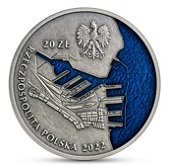

Nominał 20 zł … metal: Ag 925/1000; stempel: zwykły, transparentna żywica, oksyda; średnica: 38,61 mm; masa: 28,28 g; brzeg (bok): gładki; nakład: do 12 000 szt.; Projektant: Dominika Karpińska-Kopiec; Emitent: NBP; Na zlecenie NBP monety wyprodukowała Mennica Polska S.A.
Na mocy traktatu wersalskiego Polska otrzymała wąski pas wybrzeża (ok. 140 km z Półwyspem Helskim włącznie) i prawo do korzystania z portu w Gdańsku. W praktyce jednak, w związku ze szczególnym statusem Gdańska jako Wolnego Miasta, wykorzystanie istniejącego portu na potrzeby militarne i handlowe Polski nie było w pełni możliwe. W 1920 r., kilka miesięcy po uroczystości zaślubin Polski z morzem, Ministerstwo Spraw Wojskowych oddelegowało inż. Tadeusza Wendę do wyznaczenia dogodnej lokalizacji pod budowę przyszłego portu. W czerwcu 1920 r. Tadeusz Wenda złożył sprawozdanie z przeprowadzonych oględzin i obserwacji Wybrzeża. Dogodne położenie Gdyni zapewniające m.in. osłonięcie od wiatrów przez Półwysep Helski, odpowiednia głębokość wody przy brzegu oraz bliskość stacji kolejowej zaważyły na wyborze tego właśnie miejsca. Później wszystko potoczyło się dość szybko. W ciągu dwóch lat (1921–1923) powstał Tymczasowy Port Wojenny i Schronisko dla Rybaków. Jednocześnie w 1921 r. Wenda przygotował koncepcję portu właściwego o zdolności przeładunkowej 6 mln ton. Rok później, 23 września 1922 r., Sejm RP przyjął ustawę o budowie portu w Gdyni. W artykule 1 dokumentu czytamy: „Upoważnia się Rząd do poczynienia wszelkich niezbędnych zarządzeń celem wykonania budowy portu morskiego przy Gdyni na Pomorzu, jako portu użyteczności publicznej”. Datę podjęcia uchwały przyjmuje się za formalny początek Portu Gdynia.
Awers monety o nominale 20 zł przedstawia plan gdyńskiego portu. Jako wzór posłużył plan w postaci światłokopii kolorowanej ze zbiorów Muzeum Miasta Gdyni wykonany przez Leona Wilbika na podstawie projektu Tadeusza Wendy. Plan sporządzono prawdopodobnie ok. 1936 r. Ukazuje on stan portu na ten rok, a także Kanał Przemysłowy (który ostatecznie nigdy nie powstał), część magazynów portowych oraz nabrzeży i basenów znajdujących się w planach budowy na kolejne lata.
Na rewersie widnieje popiersie Tadeusza Wendy wykonane na podstawie fotografii portretowej z 1918 r., która jest przechowywana w zbiorach Muzeum Miasta Gdyni. Ukazane na pierwszym planie fragmenty portalu dźwigu bramowego o ażurowej konstrukcji były używane w czasach Wendy i obecnie. Dźwigi w tle to już urządzenia współczesne. Przeszłość spotyka się z teraźniejszością portu. Informacja: dr Anna Śliwa.

100th Anniversary of the Port of Gdynia
www.nbp.pl
Narodowy Bank Polski is the central bank of the State, responsible for its monetary policy and price stability. The Bank’s functions are described in the Constitution of the Republic of Poland and the Act on NBP. NBP holds the exclusive right to issue the currency of the Republic of Poland. As the central bank, it does not provide accounts for the general public, accept deposits from or extend loans to individuals. It acts as a banker to the State budget and public sector entities. NBP also holds and manages the foreign exchange reserves of the State. Finally, it functions as a banker to banks, creating conditions for the operation of the Polish banking system. Narodowy Bank Polski is one of the most important research and analytical centres in the fields of economics and financial markets. Issuing collector items is an occasion to commemorate important historic figures and anniversaries, as well as to develop the interest of the public in Polish culture, science, and tradition. On 14 September 2022, Narodowy Bank Polski issued into circulation a silver coin “100th Anniversary of the Port of Gdynia” with a face value of 20 złoty.


Face value: 20 zł … Metal: Ag 925/1000; Finish: standard (transparent resin, oxidised); Diameter: 38.61 mm; Weight: 28.28 g; Edge (side): plain; Mintage: up to 12,000 pcs.; Designer: Dominika Karpińska-Kopiec; Issuer: NBP; The coins, commissioned by NBP, were struck by Mennica Polska S.A.
Under the Treaty of Versailles, Poland was granted a narrow strip of coastline (about 140 km including the Hel Peninsula) and the right to use the port of Gdańsk. In practice, however, due to the special status of Gdańsk as a free city, it was not fully possible to use the existing port for the military and commercial needs of Poland. In 1920, a few months after Poland’s Wedding to the Sea, the Ministry of Military Affairs commissioned engineer Tadeusz Wenda to designate a convenient location for the construction of the future port. In June 1920, Tadeusz Wenda submitted a report on the inspection and observation of the Coast. The convenient location of Gdynia, providing, among others, the protection from winds by the Hel Peninsula, sufficient depth of water at the shore and the proximity of the railway station were the reasons for choosing this particular place. Afterwards, things moved on quite quickly. Within two years (1921–1923), the Temporary Military Port and the Fisherman Shelter were developed. At the same time, in 1921 Wenda prepared the concept of the proper port with a reloading capacity of 6 million tonnes.
A year later, on 23 September 1922 the Sejm of the Republic of Poland passed the Act on the Construction of the Port of Gdynia. Article 1 of the document reads: “The Government shall be authorised to make any necessary arrangements to carry out the construction of the seaport at Gdynia in Pomerania as a public utility port”. The date of passing of the Act is recognised as the formal beginning of the Port of Gdynia.
The obverse of the 20 złoty coin depicts a plan of the port of Gdynia. The plan in the form of a coloured photocopy from the collection of the Gdynia City Museum, made by Leon Wilbik on the basis of Tadeusz Wenda’s design, was used as a model. The plan was probably drawn up around 1936. It shows the status of the port in that year as well as the Industrial Canal (which was ultimately never built), some of the port warehouses as well as embankments and basins which were planned for construction in the subsequent years.
The reverse shows the bust of Tadeusz Wenda reproduced from portrait photographs taken in 1918, which are deposited in the collection of the Gdynia City Museum. The fragments of the portal of the openwork gantry crane shown in the foreground were used in Wenda’s times and are still in use today. The cranes in the background are contemporary devices. At the port, the past blends with the present. Info: dr Anna Śliwa.

Wielcy polscy ekonomiści – Władysław Zawadzki
www.nbp.pl
Narodowy Bank Polski jest centralnym bankiem państwa odpowiadającym za politykę pieniężną i stabilność cen. Jego funkcje określa Konstytucja Rzeczypospolitej Polskiej i ustawa o NBP. NBP ma wyłączne prawo emisji pieniądza. Jako bank centralny nie prowadzi rachunków bankowych obywateli, nie przyjmuje od nich lokat, nie udziela kredytów. Prowadzi natomiast obsługę budżetu państwa, a także podmiotów sektora finansów publicznych. Gromadzi rezerwy walutowe państwa i zarządza nimi. Pełni funkcję banku banków, tworząc warunki do działania systemu bankowego. Jest również jednym z najważniejszych ośrodków naukowo-analitycznych w dziedzinie ekonomii i rynków finansowych.
Emisja wartości kolekcjonerskich stanowi okazję do upamiętniania ważnych historycznych rocznic i postaci oraz do rozwijania zainteresowań polską kulturą, nauką i tradycją. 26 października 2022 roku Narodowy Bank Polski wprowadził do obiegu srebrną monetę o nominale 10 zł z serii „Wielcy polscy ekonomiści” – „Władysław Zawadzki”.
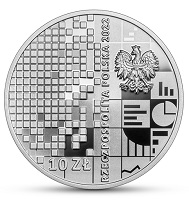
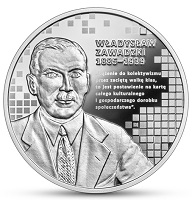
Nominał: 10 zł … metal: Ag 925/1000; stempel: lustrzany; średnica: 32,00 mm; masa: 14,14 g; brzeg (bok): gładki; nakład: do 10 000 szt.; Projektant: Dominika Karpińska-Kopiec; Emitent: NBP; Na zlecenie NBP monetę wyprodukowała Mennica Polska S.A.
Na rewersie monety, na tle stylizowanych kwadratów, znajdują się wizerunek Władysława Zawadzkiego, daty jego urodzin i śmierci oraz cytat pochodzący z dzieła Teoria produkcji. Na awersie monety, poza stałymi elementami, takimi jak wizerunek orła ustalony dla godła Rzeczypospolitej Polskiej, nominał oraz oznaczenie roku emisji, w tle widać stylizowane kwadraty i wykresy.
Władysław Marian Zawadzki (1885–1939) był ekonomistą i politykiem. Pobierał nauki na kilku uczelniach – zarówno polskich, jak i zagranicznych. W młodości sympatyzował z ruchem socjalistycznym, by później związać się ze środowiskiem wileńskich konserwatystów. Od 1917 r. wykładał ekonomię na warszawskich uczelniach i na Uniwersytecie Stefana Batorego w Wilnie. W 1931 r. objął stanowisko wiceministra skarbu, zaś rok później przyjął tekę ministra tego resortu. Funkcję tę piastował do 1935 r. Okres jego urzędowania przypadł na czas wielkiego kryzysu. Zawadzki prowadził politykę równowagi budżetowej oraz stabilnej waluty, przeciwstawiając się koncepcjom dewaluacji złotego. Minister sądził, że w państwie, które kilka lat wcześniej doświadczyło niszczących skutków hiperinflacji, takie działania – głównie ze względów psychologicznych – są niedopuszczalne. Jego polityka nie przyniosła jednak oczekiwanych rezultatów.
Od 1936 r. wykładał w Szkole Głównej Handlowej. Zawadzki był jednym z prekursorów wśród polskich uczonych zastosowania narzędzi matematycznych w ekonomii. Opowiadał się za teorią równowagi ogólnej. Miał poglądy liberalne, odrzucał koncepcje etatystyczne. Był przeciwny rozbudowanym wydatkom państwa i aktywnej polityce społecznej. Obawiał się, że nadmierne wydatki socjalne zatrzymają szybki rozwój gospodarczy Polski, a także negatywnie wpłyną na postawy społeczne, tworząc podglebie sprzyjające aktywizacji postaw roszczeniowych i osłabiając ducha przedsiębiorczości oraz wolę pracy. Wśród najważniejszych dzieł Zawadzkiego warto wymienić następujące pozycje: Zastosowanie matematyki do ekonomii politycznej, Teoria produkcji. Próba zbadania społecznych warunków produkcji oraz Manipulowanie pieniądzem jako narzędzie polityki gospodarczej. Pozostawił także Dziennik, interesujące świadectwo codziennej pracy działacza państwowego. Informacja: Grzegorz Jeż.

The Great Polish Economists – Władysław Zawadzki
www.nbp.pl
Narodowy Bank Polski is the central bank of the State, responsible for its monetary policy and price stability. The Bank’s functions are described in the Constitution of the Republic of Poland and the Act on NBP. NBP holds the exclusive right to issue the currency of the Republic of Poland. As the central bank, it does not provide accounts for the general public, accept deposits from or extend loans to individuals. It acts as a banker to the State budget and public sector entities. NBP also holds and manages the foreign exchange reserves of the State. Finally, it functions as a banker to banks, creating conditions for the operation of the Polish banking system. Narodowy Bank Polski is one of the most important research and analytical centres in the fields of economics and financial markets.
Issuing collector items is an occasion to commemorate important historic figures and anniversaries, as well as to develop the interest of the public in Polish culture, science and tradition. On 26 October 2022, Narodowy Bank Polski issued into circulation a silver coin of the series “The Great Polish Economists” – Władysław Zawadzki, with a face value of 10 złoty.


Face value: 10 zł … Metal: Ag 925/1000; Finish: proof; Diameter: 32.00 mm; Weight: 14.14 g; Edge (side): plain; Mintage: up to 10,000 pcs.; Designer: Dominika Karpińska-Kopiec; Issuer: NBP; The coins, commissioned by NBP, were struck by Mennica Polska S.A.
The reverse of the coin features the image of Władysław Zawadzki, the dates of his birth and death and a quotation from the work Teoria produkcji, all of them against the background of stylised squares. In addition to the regular elements such as the image of the Eagle established as the state emblem of the Republic of Poland, the face value and the notation of the year of issue, the obverse features stylised squares and charts which can be seen in the background.
Władysław Marian Zawadzki (1885-1939) was an economist and politician. He studied at several, both Polish and foreign, universities. In his youth, he sympathised with the socialist movement, and later became involved in the Vilnius conservative community. From 1917 he delivered lectures on economics at Warsaw universities and at the Stefan Batory University in Vilnius. In 1931, he took over the post of Deputy Minister of Treasury, and a year later accepted the office of Treasury Minister. He held this position until 1935. His period in office coincided with the Great Depression. Zawadzki pursued the policy of budget balance and stable currency, opposing the concepts of devaluing the zloty. The minister believed that in a country that had experienced the devastating effects of hyperinflation a few years earlier, such actions were unacceptable, mainly for psychological reasons. His policy, however, failed to bring the expected results. From 1936 he lectured at the Warsaw School of Economics.
Zawadzki was one of the pioneers among Polish scientists in the use of mathematical tools in economics. He was in favour of the general equilibrium theory. Zawadzki had liberal views and rejected statist concepts. He was against extensive public spending and active social policy. He was afraid that excessive social spending would bring Poland’s rapid economic development to a halt and have a negative impact on social attitudes, laying the foundations for entitlement attitudes and weakening the entrepreneurial spirit and the will to work. Among the most important works by Zawadzki, the following items are worth mentioning Zastosowanie matematyki do ekonomii politycznej [Application of mathematics in political economy], Teoria produkcji. Próba zbadania społecznych warunków produkcji [The theory of production. An attempt to investigate the social conditions of production] and Manipulowanie pieniądzem jako narzędzie polityki gospodarczej [Manipulating money as a tool of economic policy]. He also left behind Dziennik [The Diary], an interesting testimony to the daily work of a state activist. Info: Grzegorz Jeż.


Summit Series: PermanentTM domestic rate stamps
www.canadapost.ca
This booklet of 10 Permanent™ domestic rate stamps celebrate the 50th Anniversary of the 1972 Summit Series. This stamp issue marks the 50th Anniversary of the 1972 Canada-USSR hockey series, now known as the Summit Series. The stamp features an illustration by Gary Alphonso. It was inspired by a face-off between a Soviet player and Phil Esposito in Game 3 at the Winnipeg Arena, September 6, 1972. The 1970s-style ‘television’ frame of the stamp evokes the experience of the millions of Canadians who watched the games on TV, not only at home but also in schools and businesses across the country. The stamp is issued to inspire a sense of nostalgia and pride among Canadians who experienced the series and inform those who didn’t of a great moment in Canadian hockey history. The issue date for the Summit Series stamp is September 21, 2022.
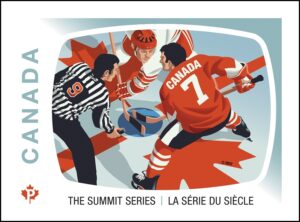
Stamp Designer: Jim Ryce Design & Direction; Stamp Illustrator: Gary Alphonso; Stamp Value: Permanent™ domestic rate; Quantity Produced: 300,000; Issue Date: September 21, 2022.
Do you remember where you were on Thursday, September 28, 1972? That was the day millions of Canadians were gathered around televisions and radios, in workplaces and schools, for a seminal moment in Canadian sports history. Team Canada scored the tie-breaking, series-winning goal in the last seconds of the third period of the Game 8 final of the Canada-USSR hockey series that has come to be known as the Summit Series. It marked the first time that the national Soviet Union team and a Canadian team (composed of professional hockey players) competed against one another in international play. Going into the third period of Game 8, the Soviet team was ahead 5 to 3. Canada scored two goals to tie the game. With only 34 seconds remaining on the clock, Paul Henderson picked up Phil Esposito’s rebound off the Soviet goalie and took another two shots – slipping his own rebound past the goalie and into the net. Canada held on for a 6 to 5 win – and the series victory. The success of the Summit Series inspired the creation of the Canada Cup tournament starting in 1976, as well as the Super Series of exhibition games between Soviet and NHL teams. In 2005, the team was inducted into Canada’s Sports Hall of Fame.

This Official First Day Cover celebrates the 50th Anniversary of the 1972 Summit Series. The Official First Day Cover features an illustration by Toronto-based artist, Gary Alphonso. The image depicts silhouetted fans, gathered around a 1970s-style television as they cheer on Team Canada 1972. The issue date for the Summit Series stamp is September 21, 2022. The cancel location is Winnipeg, Manitoba.


Truth and Reconciliation:
PermanentTM domestic rate stamps
www.canadapost.ca
Take home this booklet of 8 PermanentTM domestic rate stamps from the Truth and Reconciliation stamp issue from Canada Post. First Nations, Inuit and Métis children were forced to attend federally created Indian residential schools, which operated for nearly a century and a half. More than 150,000 children were taken from their families and communities, many never to return home.
This stamp issue is the first in a series showcasing the artistic visions of Inuit, Métis and First Nations artists for the future of truth and reconciliation. The top left image was designed by Jackie Traverse, First Nation (Lake St. Martin, MB), Anishinaabe, Ojibwe. It represents seeds of change. It features a man and woman, the elders, their children and their grandchildren. The ubiquitous bunchberry is in the centre and represents Canada, with the roots from the seeds reaching to the past. This image emphasizes the need to share the sun, water and the land to enjoy a good harvest.
The top right image was designed by Gayle Uyagaqi Kabloona, Inuit, Ukkusiksalingmiut, Qamani’tuaq (Baker Lake, NU). Gayle believes each group within Canada has a different responsibility for reconciliation. For indigenous people, the responsibility is to themselves and to others within their communities: learning or passing on our language and culture that was attacked. The image features a woman lighting a qulliq, the traditional Inuit stone lamp used for heat and light, to signify caretaking. She is carrying on in her culture as she has always done, taking care of herself and others and healing.
This image was designed by Kim Gullion Stewart, Métis, Athabasca, AB. Flowers in Métis art remind people to live in a symbiotic way with land, waterways, ecosystems and one another. In this piece, Stewart has placed beaded flowers on top of contour lines which represent the Rocky Mountains, twisty lines which represent rivers and dashes demarking political territories. “While maps like this one are a two-dimensional record of historical process and places, they are incomplete until they include elements that are important to the people who are indigenous on this continent.”

Stamp Designer: Blair Thomson | Believe in; Stamp Value:
Permanent™ domestic rate; Quantity Produced: 200,000;
Issue Date: September 29, 2022.
The bottom left image was designed by stamp designer Blair Thomson. It features a pair of bold hands held over eyes and a human face. The hands are cross-representative — belonging to the settler, masking their view of reality and shame, and to the Indigenous people/Survivors, covering their face in sadness, pain, memories. Tears stream from between the fingers. The background further connects to the school windows, looking out and dreaming of home. An Indigenous child looks out from behind the hands to reinforce the message that we must never look away again. First Nations, Inuit and Métis children were forced to attend federally created Indian residential schools, which operated for nearly a century and a half. More than 150,000 children were taken from their families and communities, many never to return home.
This stamp issue is the first in a series showcasing the artistic visions of Inuit, Métis and First Nations artists for the future of truth and reconciliation. Clockwise from top left: The artwork by First Nations artist Jackie Traverse, centred on the ubiquitous bunchberry, represents seeds of change, reminding us that for bountiful future harvests, we must share the sun, water and land. Inuit artist Gayle Uyagaqi Kabloona features a woman lighting a qulliq, the traditional Inuit stone lamp, to signify care and healing for all Indigenous communities. Métis artist Kim Gullion Stewart places beaded flowers over the contour lines of a map as a reminder of the need to live symbiotically with the land, nature and each other. Canadian designer Blair Thomson offers two perspectives – the trauma and pain endured by Indigenous Peoples and the settlers’ shame and acknowledgement of this truth. An Indigenous child looks out from behind the hands to reinforce the message that we must never look away again.
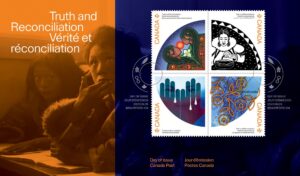
The Official First Day Cover from the Truth and Reconciliation stamp issue from Canada Post… Brantford, Ontario is the cancel location (Brantford ON) because it is the site of the Mohawk Institute (the traditional territory of the Haudenosaunee and Anishnaabeg), whose opening in the early 1830s made it Canada’s first Indian Residential School. Stamp Designer: Blair Thomson | Believe in; Stamp Value: Permanent™ domestic rate; Quantity Produced: 7,000; Issue Date: September 29, 2022.


2022 Christmas, Nativity:
PermanentTM domestic rate stamps
www.canadapost.ca
Canada Post has been issuing Christmas and holiday stamps every year since 1964. Holiday mailers and collectors can choose stamps featuring either secular holiday imagery or more traditional sacred Christmas imagery. Celebrate Christmas in 2022 with this booklet of 12 PermanentTM domestic rate stamps from our Christmas Nativity stamp issue. After they had heard the king, they went on their way, and the star they had seen when it rose went ahead of them until it stopped over the place where the child was. Matthew 2:9

This stamp issue features a creative rendering of the Nativity, with an emphasis on the star that led the Magi to the infant Jesus. In biblical accounts, the star of Bethlehem served as both a guide that led the Magi to find baby Jesus and a sign that the prophecy of the coming saviour had been realized. Scholars and astronomers have searched historical records, and even observed remnants of ancient supernovas, in an attempt to date the birth of Christ and identify the nature of such a momentous event in the heavens. However, it remains a mystery whether the unusually bright celestial light was a star, a comet, a nova, a supernova – or even a conjunction of planets, which would have been recognized as a particularly auspicious sign by the learned Magi. Regardless of its origins, the star as described in the Gospel of Matthew provides assurance that the coming of the Christ Child was the fulfilment of God’s covenant with the faithful, and it remains a shining symbol of divine guidance, particularly at Christmas time. Stamp Value: Permanent™ domestic rate; Stamp Designer: Paprika; Stamp Illustrator: Fanny Roy; Quantity Produced: 450,000; Issue Date: November 1, 2022.
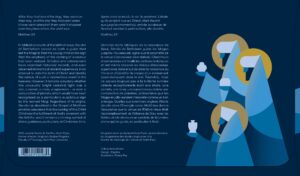
2022 Christmas, Nativity: Official First Day Cover … Canada Post has been issuing Christmas and holiday stamps every year since 1964. Holiday mailers and collectors can choose stamps featuring either secular holiday imagery or more traditional sacred Christmas imagery. Celebrate Christmas in 2022 with the Official First Day Cover for our Christmas Nativity stamp issue. This OFDC is cancelled in Star City, Saskatchewan. Stamp Value: Permanent™ domestic rate; Cancellation Site: Star City, Saskatchewan; Stamp Designer: Paprika; Stamp Illustrator: Fanny Roy; Quantity Produced: 5,500; Issue Date: November 1, 2022.


2022 … Diwali: PermanentTM domestic rate stamps
www.canadapost.ca
Celebrate Diwali and send good wishes to your family and friends with this booklet of 6 PermanentTM domestic rate stamps. This stamp heralds the arrival of Diwali, one of the largest and most widely celebrated festivals in India. Observed by Hindus, Sikhs, Buddhists, Jains and other communities in Canada and around the world, the Festival of Light – as it is also known – falls this year on October 24. Stamp Value: Permanent™ domestic rate; Stamp Designer: Paprika; Quantity Produced: 100,000; Issue Date: October 6, 2022.
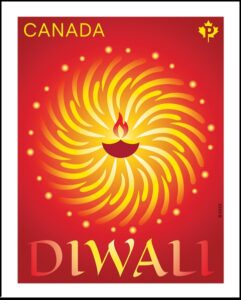
Tales differ about the origins of Diwali. According to one legend dating back to 650-550 BCE, the festival originated to honour the return of Prince Rama and his wife, Sita, after 14 years in exile. Rama, who was to assume the throne, was banished from Ayodhya at the bidding of his stepmother, who wanted her own son to become ruler. Rama and Sita were living in the forest when Sita was kidnapped by the 10-headed demon king, Ravana. After slaying the tyrant in an epic battle, Rama freed his wife and returned home, triumphant. The couple, soon to be crowned king and queen, arrived to find their path – and their village – illuminated with dīpāvali (rows of oil lamps, or diyas), from which the word Diwali is derived.
Today, fireworks are set off and millions of candles, lamps and colourful lights are used to decorate homes and communities around the world in honour of Diwali. This year, Diwali falls on October 24, 2022. The stamp design features an illustration by Arthur Grivel – of the Montréal design firm Paprika – of two traditions that are central to the celebration of Diwali: the lighting of small lamps called diyas and the setting off of fireworks. Fluorescent ink applied to parts of the stamp intensifies its colour and gives it a glowing appearance when exposed to black light. The front of the stamp booklet features illustrations of fireworks at night – a central part of Diwali celebrations. The colourful images are also evocative of the intricate Rangoli patterns created on the floors of entrance ways to welcome good fortune during the celebration.
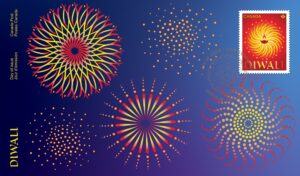
2022 … Diwali: Official First Day Cover … Celebrate Diwali, the Festival of Lights, with this Official First Day Cover. This stamp heralds the arrival of Diwali, one of the largest and most widely celebrated festivals in India. Observed by Hindus, Sikhs, Buddhists, Jains and other communities in Canada and around the world, the Festival of Light – as it is also known – falls this year on October 24. The issue was cancelled on October 6, several weeks ahead of Diwali. The cancel location is Calgary, Alberta, a city that is home to a large population of Indo-Canadians.
The Official First Day Cover design features illustrations of fireworks at night – a central part of Diwali celebrations – by Arthur Grivel, of the Montréal design firm Paprika. The colourful images are also evocative of the intricate Rangoli patterns created on the floors of entrance ways to welcome good fortune during the celebration. The cancel image is a line drawing of a Rangoli pattern with a diya at its centre. Stamp Value: Permanent™ domestic rate; Cancellation Site: Calgary AB; Stamp Designer: Paprika; Quantity Produced: 4,500; Issue Date: October 6, 2022.

2022 … $50 Pure Silver Coin – Canadian Collage
www.mint.ca www.canadapost.ca
Canada in colour! Gorgeous grasslands, show-stopping shorelines, mighty mountains, and more—all of these breath taking places exist within our borders, and each contains its own assortment of beautiful flora and fauna. Inspired by our classic circulation coin designs, this 3 oz. coin’s colour-over-engraved portrait celebrates the diversity of our landscapes through the seasons, and it’s all framed by the mighty maple leaf that proudly identifies Canada to the world. Iconic wildlife and landscapes come together to represent Canada as a whole.
Images that inspire national pride … From east to west and across the north, the reverse design whisks you on a cross-country journey to some of Canada’s most amazing places and sights. Vibrant colours … On your coin’s reverse, a large maple leaf gives shape to the eye-catching collage of colour-over-engraved images that inspire pride for Canada’s incredibly diverse—and highly photogenic—landscapes. A nod to our circulation coins … Take a close look at the animals featured here: they’re based on our animal-themed circulation coin designs! The polar bear ($2), the loon ($1), the caribou (25 cents) and the beaver (5 cents) are each depicted in their natural habitat.

Face value: 50 dollars … Composition: 99.99% pure silver
with colour over engraved relief EmbellishmentsColoured;
Mintage: 3,000; Finish: Proof; Weight: 94.25g; Diameter: 55 mm;
Edge: serrated; Artist: Lindstrom-Milne (reverse);
Packaging: Black clamshell with black beauty box.
Did You Know? … *** If you’re hoping to see the aurora borealis in person, nature’s most colourful light show is best viewed between September and April in Northern Canada. Yellowknife, N.T. is a prime Canadian destination for viewing these “Northern Lights” on a clear night, but it’s possible to catch a glimpse of it from elsewhere in Canada during a period of heightened geomagnetic activity. *** The famous Niagara Falls are actually three separate waterfalls that straddle the Canada-United States border—the largest one, the Horseshoe Falls (featured on this coin), is mostly located on the Canadian side. In the summer, more than 168,000 cubic metres of water rush over the falls every minute during peak hours (the flow is impacted by nearby hydroelectric plants). All of that water erodes the crest of the falls at an estimated rate of 1 foot every year, although it could be reduced further to 1 foot every 10 years.
The reverse design by artist Caitlin Lindstrom-Milne features several engraved maple leaves in the breeze; these form a backdrop to a larger maple leaf, which gives shape to a colour-over-engraved collage of iconic Canadian landscapes and fauna. These famous sights are, clockwise from top: the aurora borealis; the Canadian Rocky Mountains; a forest in autumn; Niagara Falls; the red cliffs of Prince Edward Island; wheat fields representing the Prairie Provinces; Arctic glaciers; and a quiet lake setting. The animals from Canada’s circulation coins (the caribou, beaver, polar bear and loon) are also depicted in their natural habitat, while the bottom of the design is edged with wildflowers—bunchberry (Cornus canadensis), fireweed (Chamerion angustifolium) and the western red lily (Lilium philadelphicum). The obverse features the effigy of Her Majesty Queen Elizabeth II by Susanna Blunt.
Caitlin Lindstrom-Milne, Artist … “I took a surrealistic approach to this piece by having different elements of the Canadian landscapes blending into one another to create one harmonious illustration. It was an exciting challenge to capture Canada through the seasons, and I did this by utilizing warm and cool tones throughout the design while maintaining a nice balance.”
Alicia Cook Sapene, Product Manager, Royal Canadian Mint …“Nature is one of Canada’s greatest gifts! With this coin design, we wanted to capture the natural splendour of this land by featuring several awe-inspiring landscapes within the shape of our beloved maple leaf. It was a real joy working with Caitlin to bring this vision to life.”

2022 … Pure Gold Coin –
Klondike Gold Rush: Prospecting for Gold
www.mint.ca
Five nines! Made from the highest standard of pure gold—more pure than any Klondike gold nugget—this 1 oz. numismatic treasure shares the same design as its 1 oz. gold bullion counterpart, but in a luminous proof finish. Its engraved depiction of a prospector using a rocker box hints at the journey from raw gold to coins—specifically, those issued by Canada’s Mint, whose creation was accelerated by the events in the Yukon. This is the popular image of the Klondike, though not everyone benefitted from those boom days: many failed to strike it rich, and with the sudden influx of gold rushers came a series of sweeping changes that proved devastating to northern Indigenous communities and environments, leaving a complicated legacy that still reverberates today. A richly detailed design … If the reverse design seems familiar, you’ve likely seen it on the 1 oz. bullion coin, 2022.

Face value: 350 dollars … Composition: 99.99% pure gold;
Mintage: 400; Finish: Proof; Weight: 31.16g; Diameter: 34 mm;
Edge: serrated; Artist: Steve Hepburn (reverse);
Packaging: Black clamshell with black beauty box.
Did You Know? … *** You’ll never find a naturally formed 100% pure gold nugget. Most fall somewhere between 70% to 95% pure gold, while the remainder consists of other alloys, such as copper, nickel and/or silver. This varies depending on the geographic location, and natural variations in gold purity can occur even within the same deposit or vein. *** The prospector’s pan was the simplest way of collecting Klondike gold, but most of the placer gold deposits lay buried near the bedrock. To reach these, prospectors needed to tunnel horizontally—a process known as drift mining. Miners used this method in the winter, when the ground was too frozen to collapse, and the “paydirt” would be piled up until the gold could be separated from the gravel in the spring. Shown here, the rocker box was favoured for one-man operations: water was poured into the top and a rocking movement helped separate the gravel from the gold, which was caught by riffles that lined the bottom of the box.
Designed by Canadian artist Steve Hepburn, your coin’s reverse takes us back in time for an idealized view of the Klondike Gold Rush experience from a prospector’s perspective. Standing at the edge of a stream, a prospector is seen pouring water from a ladle (“dipper”) into the top of a rocker box (“cradle”), which would then be rocked from side-to-side to separate gold from the sand and gravel. The water pouring out of the box gradually takes on the appearance of molten metal to represent the journey from raw material to refined precious metal, and ultimately, to the pure gold coins issued by the Royal Canadian Mint, represented by the Gold Maple Leaf bullion coin’s design. The obverse features the effigy of Her Majesty Queen Elizabeth II by Susanna Blunt.
Steve Hepburn, Artist … “Would-be prospectors left their former lives behind and travelled over perilous mountain passes, thick forests and dangerous conditions in hopes of reaching pay dirt and striking it rich. Their work was gruelling, and the invention of the rocker box must have seemed like a gift from above—the prospector could now move many times more material, which would hopefully lead to bigger yields of gold. The strength, dedication and internal fortitude that was needed to live and work in these rugged conditions is hard for us to conceive. Perhaps the greatest thing that the invention of the rocker box gave the prospectors was hope.”

Lenticular Coin – Santa’s Sleigh
www.mint.ca www.canadapost.ca
Step inside Santa’s workshop! It’s Christmas Eve at the North Pole, and while Santa Claus is busy putting on his red suit, these elves are loading toys and gift boxes onto his sleigh. This lenticular coin offers a sneak peek at preparations for Santa’s annual gift delivery. His magical helpers are working as fast as they can, but look out! When the coin is tipped, the elves will have to act quickly to catch those falling boxes. Create some magic and memories with this fun holiday coin.
A playful design … Take a sneak peek inside Santa’s workshop—see how the elves are checking the list (twice) and loading Santa’s magical sleigh! It’s a colourful, festive scene that is sure to put a smile on your face. Motion-filled reverse … Your coin is crafted in colour using the latest lenticular technology to deliver fluid, uninterrupted movement. Simply tip the coin to change your viewing angle, and the scene suddenly shifts as some of the gifts accidentally slip from the top of the pile!
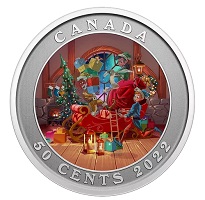
Face value: 50 cents … Composition: Nickel plated steel;
Mintage: 100,000; Finish: Modified specimen; Weight: 12.61g;
Diameter: 35 mm; Edge: plain; Artist: Jesse Koreck (reverse);
Packaging: Black clamshell with black beauty box.
Did You Know? … *** Santa’s elves were a well-kept secret until the 1800s—in fact, no one knew Santa Claus himself was a “jolly old elf” until it was revealed in the poem A Visit from St. Nicholas (you probably know it as The Night Before Christmas).
Designed by Canadian artist Jesse Koreck, your coin’s reverse is enhanced with lenticular technology, which creates a sense of motion through the seamless transition between two interlaced colour images. Both images capture the excitement and activity at the North Pole on Christmas Eve, as Santa’s industrious elves load toys and gift boxes onto his magical sleigh. While one helper is checking the list, the elf in the foreground races to assist another with a stack of gifts; when the coin is tipped, the second image shows the panic on the elves’ faces as some of the gifts fall from the top of the pile. The obverse features the effigy of Her Majesty Queen Elizabeth II by Susanna Blunt.

2022 … New pure silver puzzle coin set
www.mint.ca
New puzzle coin set shows a nation on the move … Look to the North Star for direction in this journey through Canada’s history! Like tinted memories, and inspired by iconic images from our past, the colour depictions on the 13 puzzle-shaped coins trace the evolution of transportation in Canada, culminating in the geography-themed centrepiece. But this set represents more than just a timeline of travel – it’s about connections, for as the nation evolved, so too did the transportation links that keep us connected and moving forward together.
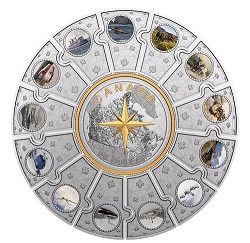
The puzzle-shaped coins include depictions of: *** Kayak; *** Stagecoach; *** Prairie Schooner; *** Voyageur Canoe; *** Railway; *** Dogsled; *** Passenger Steamboat; *** Passenger Liner; *** Air Transport; *** Snowmobile; *** Pontoon Airplane; *** Passenger Bus; *** Train Ferry.

A Retro Look … More than 1,000 years of making history – of making connections – are represented by the vintage-tinted portraits and the interconnected maple leaves featured on each puzzle-shaped coin. Includes mini booklet … Your puzzle coin set comes with a special mini-booklet that explains each mode of transportation and its place in Canadian history.
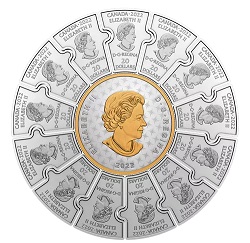
Face value: Centre coin: $50, Puzzle pieces: $20… Composition: Centerpiece: 99.99% pure silver with gold plating, Puzzle pieces: 99.99% pure silver Embellishments Plating; Mintage: 800; Finish: Proof; Weight: 502.47g; Dimensions: 184 mm x 184 mm; Diameter: 123.7 mm; Edge : Interrupted serrations; Artist: Centrepiece: Alex Tirabasso, Puzzle pieces: Trevor Tennant; Packaging: Wood case with special booklet.
On the selectively gold-plated $50 centrepiece, the reverse design by Royal Canadian Mint engraver Alex Tirabasso features a compass rose over a map of Canada that represents history, exploration and travel; the compass rose also forms a repeating pattern on the obverse. Designed by artist Trevor Tennant, and inspired by period imagery, the puzzle-shaped $20 coins feature colour snapshots of 13 historically significant modes of transportation and a pattern of interconnected maple leaves. Each obverse features the effigy of Her Majesty Queen Elizabeth II by Susanna Blunt.

2022 … Pure Silver Coin – Holiday Gifts
www.mint.ca
Get into the holiday spirit with the help of Santa’s fast-moving elves. He’s made a list… and now he’s checking it twice! Continuing the holiday theme introduced in 2020, our 2022 movement coin features a whimsical 3D sculpt of Santa Claus, cast in sterling silver and surrounded by a gold-plated garland. While Santa takes a moment to review this year’s Naughty or Nice list, his happy helpers are busy putting the final touches on all the Christmas preparations—tilt the coin and watch the merry elves move!
A 3D Santa … Your coin’s reverse features two separate 3D elements that have been cast in sterling silver (92.5% pure): Santa Claus surrounded by gifts, and three merry elves. Gold plating … Selective gold plating highlights the rim on both sides of your coin, as well as the effigy on the obverse and the elegantly decorated garland on the reverse. Special Packaging … Instead of being enclosed in a regular capsule, your coin sits on an elegant wooden base and is protected by a clear dome that allows you to view and play with your new holiday keepsake.

Face value: 50 dollars … Composition: 99.99% pure silver with selective gold plating and embellishments cast in sterling silver; Mintage: 1,200; Finish: Proof; Weight: 157.6g; Diameter: 65.25 mm; Edge: serrated; Artist: Ryan Poser (reverse), Susanna Blunt (obverse). Packaging: Wood circular base with black beauty box.
DID YOU KNOW? … *** While elves are a mainstay of Scandinavian and Germanic folklore, Santa’s elves were a well-kept secret until the mid-1800s, when poems and illustrations provided the first glimpses of what goes on inside Santa’s magical workshop.
Designed by RCM Engraver Ryan Poser, your coin’s reverse features a 3D sculpt of Santa Claus and his elves—both are cast in sterling silver. Surrounded by toys and gifts that will soon be loaded onto his sleigh, Santa holds a scroll and takes a moment to review the Naughty or Nice list; when the coin is tilted, the three gift-bearing elves merrily move around Santa. Selective gold plating adds colour to the rim, the engraved gifts that form a base around Santa, and the decorative garland that surrounds the holiday scene. The obverse features a repeating maple leaf pattern and the effigy of Queen Elizabeth II by Susanna Blunt.


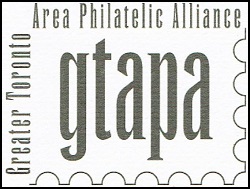
www.gtapa.org
The GTAPA is committed to promote and stimulate
the art of philately to all ages for fun,
culture, education, and friendship.





